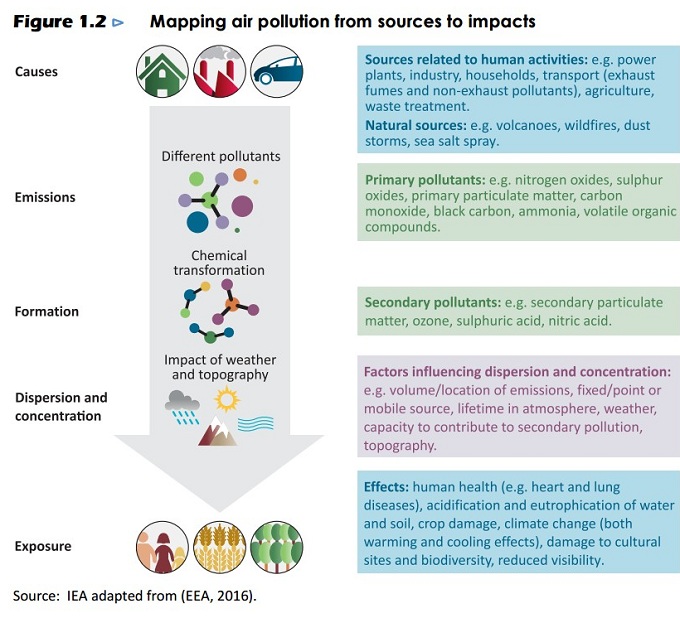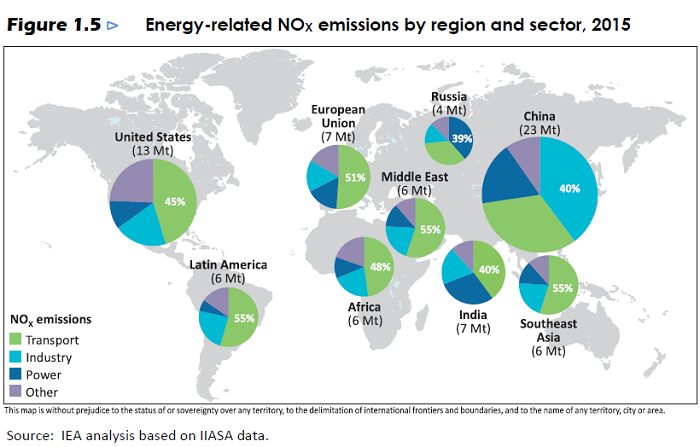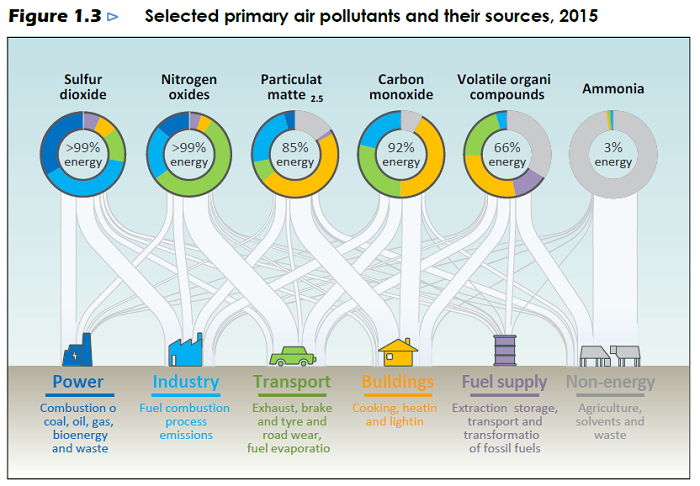Asia will account for almost 90 percent of the rise in deaths, the International Energy Agency warns
By Sana Jamal
Today, no country in the world is immune to air pollution as a staggering 80% of the population living in cities are breathing air that fails to meet the air quality standards set by the World Health Organization.
Around 6.5 million die each year worldwide due to poor air quality inside and outside, making bad air the world’s fourth-largest threat to human health, behind high blood pressure, dietary risks and smoking.
International Energy Agency’s latest Energy and Air Pollution Report highlights the links between energy, air pollution and health.
A global energy strategy is needed to reduce the projected number of air pollution deaths by 3.3 million a year by 2040, according to the International Energy Agency (IEA).
In the first ever in-depth analysis of air quality, IEA urges governments to adopt Clean Air Scenario – a strategy to cut pollutants by half and to deliver cleaner air. Increasing total energy investment by 7 percent (or $4.7 trillion), through 2040, would decline premature deaths from outdoor pollution to 2.8 million and from household air pollution to 1.3 million, Report suggests.
“This is completely peanuts. With a seven percent increase you can save over three million lives,” IEA Executive Director Fatih Birol told reporters in London.
Without action, annual premature deaths caused by outdoor air pollution will increase from 3 million to 4.5 million. Asia will account for almost 90 percent of the rise in deaths.
In China, recent signs of decline are consolidated, IEA report notes. But emissions generally rise in India, Southeast Asia and Africa, as expected growth in energy demand dwarfs policy efforts related to air quality.
“Clean air is a basic human right that most of the world’s population lacks,” said EA Executive Director Fatih Birol. “We need to revise our approach to energy development so that communities are not forced to sacrifice clean air in return for economic growth.”
“Proven energy policies and technologies can deliver major cuts in air pollution around the world and bring health benefits, provide broader access to energy and improve sustainability.”
What causes Air Pollution?
Harmful pollutants such as particulate matter – which can contain acids, metals, soil and dust particles – sulfur oxides and nitrogen oxides, are responsible for the most widespread effects of air pollution. These three primary pollutants are emitted directly as a result of human activity or natural processes:
1. Particulate matter: Tiny particles that float in the air, and can be either liquid and solid. They’re linked to detrimental health impacts, such as chronic lung diseases. About 85 percent of PMs comes from the energy industry, according to the IEA.
2. Sulfur dioxide: A gas made from burning fossil fuels. Most of it comes from power plants and industrial processes such as metals processing with almost all from the energy industry. It causes adverse health effects and can also be dissolved into water, resulting in acid rain.
3. Nitrogen oxide: A greenhouse gas that contributes to climate change. Almost all of it comes from the transportation sector and power plants that burn fossil fuels. It’s a toxic gas that causes lung inflammation and other health problems when inhaled.
Primary Sources of Air Pollution
Energy production and use, mostly from unregulated, poorly regulated or inefficient fuel combustion, are the single most important man-made sources of air pollutant emissions.
1. Poverty
More than 2.7 billion people in the world use wood and other solid fuels for cooking and lighting. Smoke inhalation from this, as well as burning kerosene for lighting, is estimated to cause 3.5 million premature deaths a year, mostly women and children in developing Asia and Sub-Saharan Africa.
2. Fossil-fuel intensive industries
Power plants that burn fossil fuels and industrial facilities are major emitters. Burning coal is responsible for 60 percent of combustion-related sulfur dioxide emissions. Coal is responsible for around 60% of global combustion-related sulfur dioxide emissions – a cause of respiratory illnesses and a precursor of acid rain.
3. Urbanization
Urban cities have become pollution hotspots, as they concentrate people, energy use, construction activity and traffic, leading to dirty air. Two-thirds of the $2.3 trillion investment into pollution control technologies recommended by the IEA is to comply with elevated vehicle emissions standards. Fuels used for transport, first and foremost diesel, generate more than half the nitrogen oxides emitted globally.including ozone.
How to bring back clean air and blue skies?
“We need to revise our approach to energy development so that communities are not forced to sacrifice clean air in return for economic growth,” said Dr Birol. “Implementing the IEA strategy in the Clean Air Scenario can push energy-related pollution levels into a steep decline in all countries. It can also deliver universal access to modern energy, a rapid peak and decline in global greenhouse-gas emissions and lower fossil-fuel import bills in many countries.”
The IEA’s strategy pushes for cleaner fuels, energy efficiency, better cooking facilities and emissions controls. It also calls for a collective long-term air quality goal, policies for implementation and regulations to monitor and enforce it.
The Report highlights three key areas for government action:
- Setting an ambitious long-term air quality goal, to which all stakeholders can subscribe and against which the efficacy of the various pollution mitigation options can be assessed.
- Putting in place a package of clean air policies for the energy sector to achieve the long-term goal, drawing on a cost-effective mix of direct emissions controls, regulation and other measures, giving due weight to the co-benefits for other energy policy objectives.
- Ensuring effective monitoring, enforcement, evaluation and communication: keeping a strategy on course requires reliable data, a continuous focus on compliance and on policy improvement, and timely and transparent public information.




